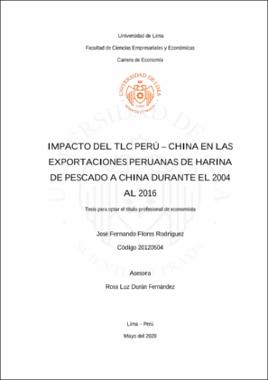Impacto del TLC Perú – China en las exportaciones peruanas de harina de pescado a China durante el 2004 al 2016

View/
Tesis
(application/pdf: 676.5Kb)
(application/pdf: 676.5Kb)
Date
2020Author(s)
Advisor(s)
Metadata
Show full item recordAbstract
The main objective of this research is to evaluate the impact of the Peru – China Free
Trade Agreement (FTA) on peruvian fishmeal exports, although all FTAs seek to
strengthen trade flows between two countries – or a set of them – not necessarily both
parties share the benefits equally. The research also focuses on studying six years before
and after the FTA was signed (FTA was effective since March 2010) which will allow us
to draw conclusions based on two “different” scenarios.
Perú is the main exporter of fishmeal in the world and has as its potential demand
the chinese market; however, one issue should be highlighted. Can the FTA generate a
negative impact on peruvian fishmeal exports after the signing of the agreement? To
answer that question, we must apply and understand the economic theory behind, the
concepts of international trade ans characteristics of demand. Also it is important to study
and measure the immersed variables that may be the cause of the phenomenon such as
international prices, GDP, terms of trade, inflation and real exchange rate that will serve
as key tools at the moment of assess the impact of the FTA through an econometric
model.
Finally, international trade theory explains that FTA will energize all sectors of
the economy of both countries. However, this research shows that the phenomenon does
not apply in the case of Peruvian exports of fishmeal to China. It is necessary to go
further. La presente investigación tiene como objetivo principal evaluar el impacto del Tratado
de Libre Comercio (TLC) Perú – China en las exportaciones peruanas de harina de
pescado, ya que si bien todo TLC busca fortalecer los flujos comerciales entre dos países
– o un conjunto de ellos - no necesariamente ambas partes se reparten los beneficios
equitativamente. Asimismo la investigación se centra en estudiar seis años pre y post
firma del tratado entre Perú y China (vigente desde marzo de 2010) lo que nos permitirá
sacar conclusiones en función a dos escenarios “distintos”.
Perú es el principal país exportador de harina de pescado del mundo y tiene como
su potencial demanda el mercado chino; sin embargo cabe resaltar un tema ¿Puede el
TLC impactar de manera negativa en las exportaciones peruanas de harina de pescado
después de la firma del convenio? Para responder esa pregunta hay que tratar y entender
la teoría económica detrás, conceptos del comercio internacional y características de la
demanda. Asimismo, es importante estudiar y medir las variables inmersas que pueden
ser causa del fenómeno tales como precios internacionales, PBI, términos de intercambio,
inflación y tipo de cambio real que servirán como herramientas claves al momento de
evaluar el impacto del TLC mediante un modelo econométrico completo.
Finalmente, aunque la teoría del comercio internacional explica que el TLC
dinamizará todos los sectores de la economía de los países involucrados, los resultados
de la presente investigación demuestran que esta predicción no aplica para el caso de las
exportaciones peruanas de harina de pescado a China. Es necesario ir más allá.
How to cite
Flores Rodriguez, J. F. (2020). Impacto del TLC Perú – China en las exportaciones peruanas de harina de pescado a China durante el 2004 al 2016 (Tesis para optar el Título Profesional de Economista). Universidad de Lima.Publisher
Universidad de LimaSubject
Work type
TesisCollections
- Tesis [127]
The following license files are associated with this item:

